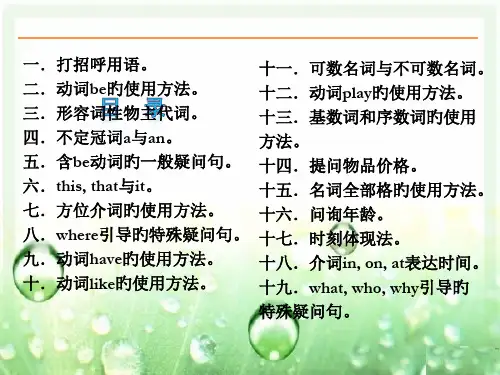人教版初中英语说课省一等奖课件(全英文)45101412
- 格式:ppt
- 大小:848.50 KB
- 文档页数:24
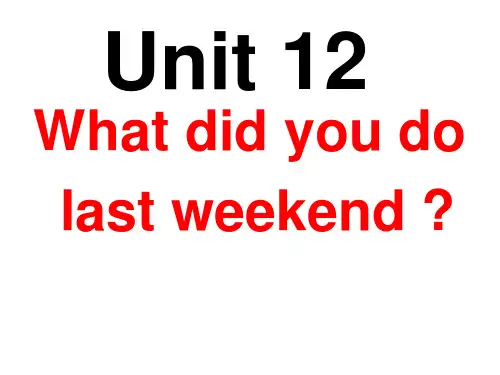

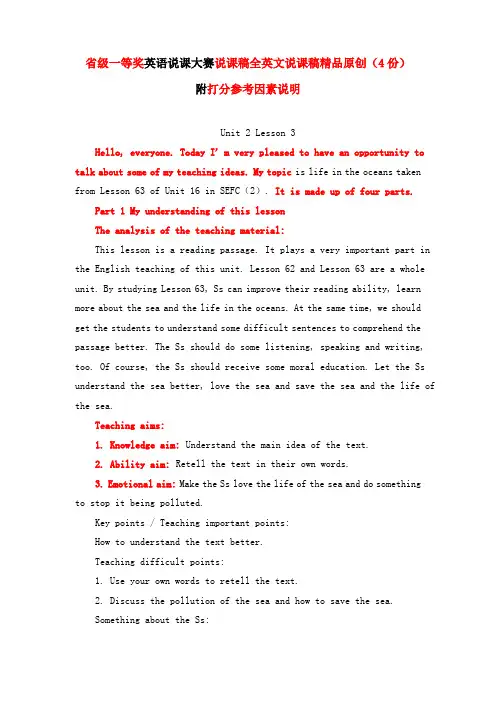
省级一等奖英语说课大赛说课稿全英文说课稿精品原创(4份)附打分参考因素说明Unit 2 Lesson 3Hello, everyone. Today I’m very pleased to have an opportunity to talk about some of my teaching ideas.My topic is life in the oceans taken from Lesson 63 of Unit 16 in SEFC(2).It is made up of four parts.Part 1 My understanding of this lessonThe analysis of the teaching material:This lesson is a reading passage. It plays a very important part in the English teaching of this unit. Lesson 62 and Lesson 63 are a whole unit.By studying Lesson63,Ss can improve their reading ability,learn more about the sea and the life in the oceans.At the same time,we should get the students to understand some difficult sentences to comprehend the passage better. The Ss should do some listening, speaking and writing, too. Of course, the Ss should receive some moral education. Let the Ss understand the sea better, love the sea and save the sea and the life of the sea.Teaching aims:1. Knowledge aim: Understand the main idea of the text.2. Ability aim: Retell the text in their own words.3.Emotional aim:Make the Ss love the life of the sea and do somethingto stop it being polluted.Key points / Teaching important points:How to understand the text better.Teaching difficult points:1. Use your own words to retell the text.2. Discuss the pollution of the sea and how to save the sea.Something about the Ss:1.The Ss have known something about the sea and sea life through the Internet and other ways.2. They are lack of vocabulary.3.They don’t often use Englis h to express themselves and communicate with others.4.Some Ss are not active in the class because they are afraid of making mistakes.Part 2 My teaching theories, methods and aidsBefore dealing with this lesson, I’ll do my best to carry out the following theories:Make the Ss the real masters in class while the teacher himself acts as director; Combine the language structures with the language functions; Let the students receive some moral education while they are learning the English language.Teaching method:Double activities teaching methodQuestion-and-answer activity teaching methodWatch-and-listen activityFree discussion methodPair work or individual work methodTeaching aids:1. a projector2. a tape recorder3. multimedia4. the blackboardPart 3. Teaching steps / proceduresI have designed the following steps to train their ability of listening, speaking, reading and writing, especially reading ability.The entire steps are:Greetings, Revision, Lead-in and preparation for reading, Fast reading(scanning),Listening,Intensive reading,Preparation for detailsof the text, Consolidation, Discussion, HomeworkStep 1 GreetingsGreet the whole class as usual.Step 2. Revision1. Ask students some questions to revise the last lesson(show them on the screen).a. How much salt do the oceans contain per thousand parts of water?(35 parts of salt. 3.5% by weight)b. What is coral? Why are corals not found in deep water?c. Why is the Dead Sea called the Dead Sea?2. Check the homework(made a survey about the sea or sea life by surfing the Internet or asking for help from other people).Through this part we can consolidate what they studied yesterday, communicate with others about their survery results and prepare for the new lesson.Step 3. Lead-in and preparation for readingShow them some pictures and let them talk each other, and then use the pictures about sea and life in the oceans to learn new words, for example, Antarctica, huge whale, sperm whale, squid and so on.Purpose: Arouse the students’ intere st of study.Bring in new subject: Life in the oceans.Step 4. Fast readingRead the passage as quickly as they can. I show the questions on the screen and let them get the main idea of each paragraph:1. Why can living things live in such oceans around the Antarctica?2. What does the whale feed on?3. What is the difference between the sperm whale and other whales?Method: Read the text individually, use question—and—answer activity.Purpose: Improve the students’ reading ability.Understand the general idea of each paragraph.Step 5. Listening(book closed)1. Listen to the tape then do an exercise(wb page 90, part 1)2. True or false exercise.(on the screen)Train the Ss’ listening ability and prepare for later exercises.Step 6. Intensive readingRead the passage carefully again and answer some detailed questions on the screen.1. How much does a whale eat at a time?2. Do all the whales feed on small fish?3. How deep can a sperm whale dive?It is also called depth reading or study reading. It means reading for detailed information.Purpose:Further understand the text(Train further reading ability)to find out some different sentences and details of the text.Step 7. Preparation for details of the text on the screen1. ...its heart slows to half its normal speed.slow-v. to become / make slower.2. ing sound wavePresent participle used as adverbial.3. provide sth. for sb.provide sb. with sth.4. at a time: each time5. grow to a length of...Purpose: Train the Ss’ ability of understanding and using laguage.Step 8. Consolidation1. Find out the topic sentences.2. Retell the passage according to the topic sentences.Purpose:I want to know if my students understand the whole text really and if they master what I mean to tell them in this class. What’s more, I want to let them have the ability of introducing and analyzing expression. At the same time,I will write down the topic sentences on the blackboard according to what the students find, so they can retell it easily.Step 9. DiscussionShow them some pictures about the polluted sea and many living things which are in danger and ask them: What are their opinions about it? In order to let them have free choice, I give them another topic: The seais being polluted. What should they do?Purpose: I mean to give them emotional education. I give themmulti-media pictures to arouse their interest of study and their love for life. I mean to make them realize: The sea is in danger!I teach them to do their best to help it and do something from now on. Everyone should do something to love and protect our home.Step 10. HomeworkWrite an article Saving the sea.I want to improve the ability of their writing.At the same time,train the ability of do-it-yourself and lookingup the information by themseleves.Part 4. Blackboard designUnit 16 Lesson 63Topic Sentences:1. Some living things can live in Antarctica.(what)2. The whale feeds on small fish.(what)3. The sperm whale feeds on squid.(difference)Discussion:1. The whales are in danger. What’s your opinion about it?2. The sea is being polluted. What should we do?In my opinion, the blackboard design can reflect the teacher’s ability of mastering the text and leading the students to master the text easily.In this text, the design is not easy to write. I write the topic sentences on the blackboard in order to tell the students that this is of the importance in this class. The discussion is of the difficulty.I want to make the design inductive, instructive and artistic.阅读课(全英)经典初中英语说课稿(2)Good afternoon, my dear judges, I am———, from————, it is my great honor to have this opportunity to talk about my teaching ideas. My presentation consists of five parts.Part 1The analysis of the teaching materialThis lesson is a reading passage, which focused on the topic of __________________, such a topic is related to our daily life, so it is easy to arouse the Ss’ learning interests. My teaching objectives include the following parts.First, the knowledge objective:1.By the end of this lesson,Ss can learn the new words and newphrases:______________________________________2.Understand the main idea of the article;3.And master the usage of ___________________(某个语法点)Second, the Ability objective:1.skim for the main idea of the article and2.scan for the specific information,3.predict some information and4.understand the whole article, and5.Enlarge the relative knowledge by reading more materials in library or frominternet, write a report of the topic, etc.Third the emotional objective:1.to develop the spirit of cooperation through teamwork and pair-discussion;2.arouse Ss’ interest in English learningForth, the Cultural awareness(根据内容而定)________________________________________________Fifth the Important points:1.to get an overall understanding of the whole text,2.and develop their reading skills such as anticipating,skimming,scanning,summarizing language points…..…(具体课型用具体例子阐述)3.the usage of the______________________(语法或句型)While the Difficult points:Are enabling the Ss to use the new words and phrases to express their ideas in daily life, and develop the ability of skimming and scanning.master the usage of ____________________________(语法或句型)根据教学过程设计的内容来决定)Part 2 The analysis of studentsThe Ss have learned English for some years. They understand some words and simple sentences.They are curious,active,and fond of game,competition,and various activities. They enjoy learning through cooperation in a relaxing atmosphere.Part 3Teaching methodsIn this lesson, My teaching methods includeaudio-visual teaching method,communicative teaching method,and task-based teaching methods.Besides,a computer,blackboard,a tape recorder,a projector are needed as the teaching aids.Part 4Teaching proceduresThere are five steps in my teaching procedures. But before teaching, I will divide the whole class into4groups to do competitions while finish different tasks in this lesson.Step 1 Warming-up and leading in (3mins)Free talk; talk something related the topic of the article.参考活动:Brainstorming, setting the scene, show pictures etc.Purpose:activate the Ss to regard the topic of___________________(主题)and create a relaxing atmosphere.Step 2 Pre-reading (10mins)●There are 3 tasks for the Ss.●Do a guessing game.●Show some funny pictures and sentences on PPT and then ask the Ss to●Guess the meaning of the new words.●Practice the new words and phrases:●Match the new words and phrases with the Chinese meanings.●Predicting: based on the title/ pictures on the text. (看具体情况而定) Purpose: through guessing, to arouse Ss learning interest, and help them to learn the new words and phrases which they may come across while reading, pave the way for the following learning and cultivate the ability of anticipating.{Meanwhile, pronunciation of some letter strings such as “ea” (pea, tea, feast..) and “er” (cucumber…) are highlighted so as to foster students’ phonetic sensitivity.}(如果有语音教学则可渗透。
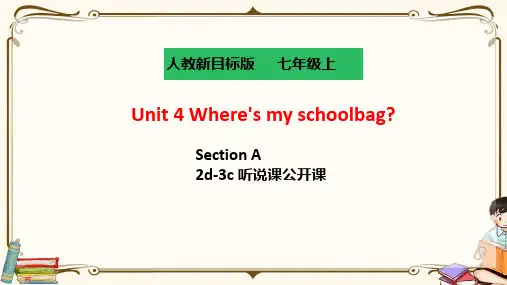
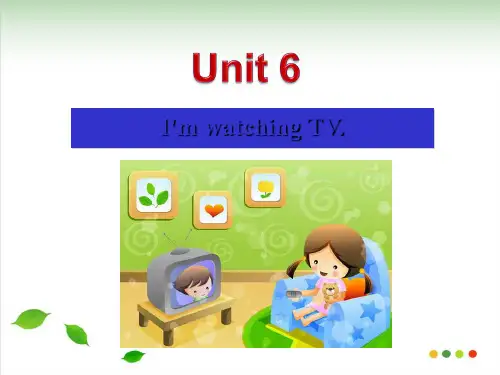
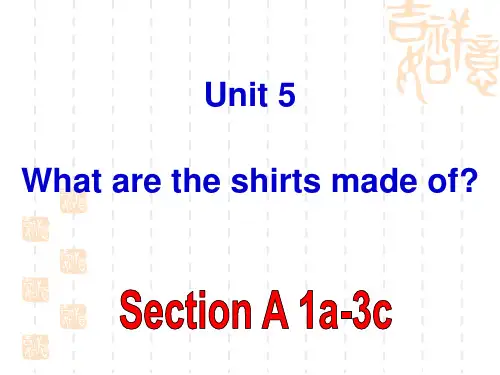
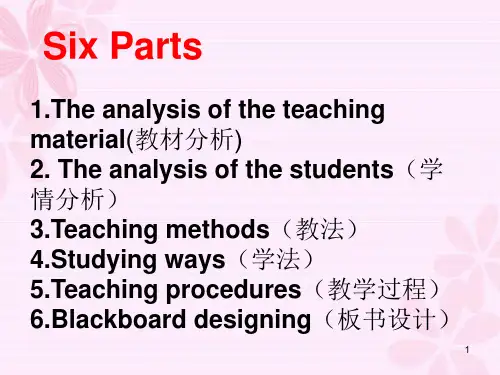
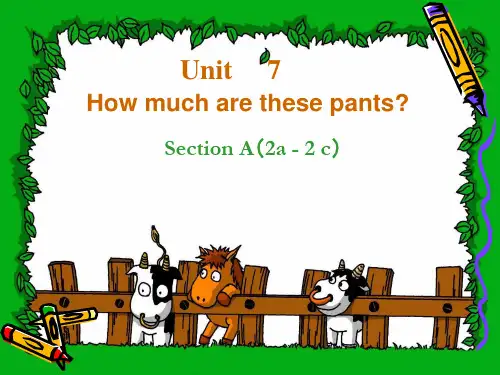
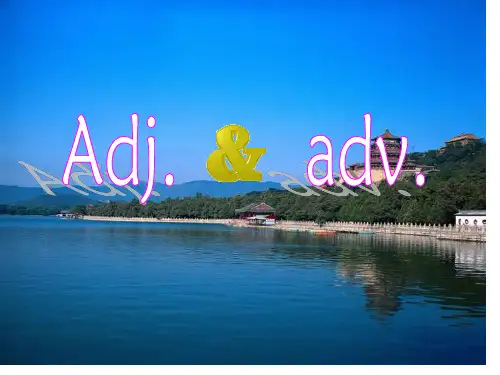
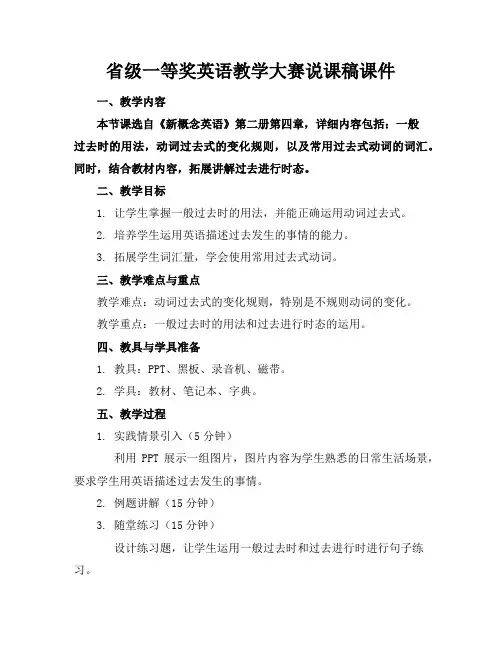
省级一等奖英语教学大赛说课稿课件一、教学内容本节课选自《新概念英语》第二册第四章,详细内容包括:一般过去时的用法,动词过去式的变化规则,以及常用过去式动词的词汇。
同时,结合教材内容,拓展讲解过去进行时态。
二、教学目标1. 让学生掌握一般过去时的用法,并能正确运用动词过去式。
2. 培养学生运用英语描述过去发生的事情的能力。
3. 拓展学生词汇量,学会使用常用过去式动词。
三、教学难点与重点教学难点:动词过去式的变化规则,特别是不规则动词的变化。
教学重点:一般过去时的用法和过去进行时态的运用。
四、教具与学具准备1. 教具:PPT、黑板、录音机、磁带。
2. 学具:教材、笔记本、字典。
五、教学过程1. 实践情景引入(5分钟)利用PPT展示一组图片,图片内容为学生熟悉的日常生活场景,要求学生用英语描述过去发生的事情。
2. 例题讲解(15分钟)3. 随堂练习(15分钟)设计练习题,让学生运用一般过去时和过去进行时进行句子练习。
4. 互动环节(10分钟)分组讨论,每组选一个话题,用英语讨论过去发生的事情,然后进行分享。
5. 课堂小结(5分钟)6. 课后作业布置(5分钟)布置作业,要求学生用英语写一篇关于过去发生的事情的短文。
六、板书设计1. 一般过去时的用法2. 动词过去式的变化规则3. 常用过去式动词词汇七、作业设计1. 作业题目:Write a short story about something that happened in the past.八、课后反思及拓展延伸1. 课后反思:关注学生对一般过去时和动词过去式的掌握程度,及时调整教学方法,提高教学效果。
2. 拓展延伸:推荐学生阅读英语故事,增加词汇量,提高英语表达能力。
同时,鼓励学生参加英语角活动,提高口语水平。
重点和难点解析1. 动词过去式的变化规则2. 一般过去时和过去进行时的运用3. 课后作业的设计与实施详细补充和说明:一、动词过去式的变化规则1. 规则动词过去式的变化规律:通常在动词原形后加ed,如:walk → walked。
